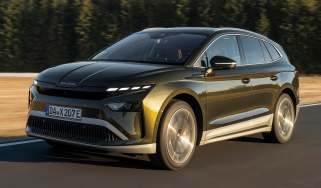Volkswagen Eos 2.0 TDI Bluemotion Technology
Fresh folding hard-top looks to strengthen grip on class
The VW Eos proved to be a breath of fresh air when it hit showrooms in 2006. With its clever five-piece folding metal and glass hard-top, it served up a combination of wind-in-the-hair thrills, sleek coupé styling and four-seater practicality.
And while it wasn’t the first family coupé-cabriolet, it was the best of the lot.
However, in the past few years, a host of new rivals has appeared, all hoping to steal the VW’s crown. So, in a bid to stay ahead of the pack, bosses have given the car a mid-life refresh.
Not that the changes are particularly obvious. In place of the previous model’s distinctive chrome-trimmed nose is a subtle black grille and a pair of swept-back headlamps, while the rear benefits from reworked LED tail-lamps. Elsewhere, the car shares its handsome and well proportioned looks with its predecessor, and with the roof up or down it’s more attractive than the slightly ungainly Renault.
Climb aboard and it’s clear that tweaks to the cabin have been kept to a minimum. The dash has been carried over unchanged; this assures an uncluttered layout and top quality, although it lacks the Mégane’s flair and kit count.
At least the driving position is spot-on, while occupants in the rear get slightly more legroom than in the Renault.
Used - available now

2023 Mercedes
C-Class Cabriolet
22,908 milesAutomaticPetrol2.0L
Cash £25,900
2025 Audi
A4 Avant
16,680 milesAutomaticPetrol2.0L
Cash £26,200
2022 Peugeot
E-2008
53,032 milesAutomaticElectric
Cash £13,000
2021 Toyota
Aygo
25,155 milesManualPetrol1.0L
Cash £9,500Sadly, it can’t match its rival for practicality. With the roof raised, there’s only 380 litres of carrying capacity, which is 37 litres less than the Mégane can muster. Lowering the top reduces the available space to 205 litres, and leaves a narrow opening to load luggage through. Yet while the VW’s folding hard-top is bulky, it feels more solid.
When it’s in place, it isolates occupants more effectively from road and wind noise, plus the panoramic glass section opens separately as a large tilt-and-slide sunroof. Press a button on the centre console, and the top lowers in a leisurely 27 seconds. A wind deflector is available as a £255 option, but even without it, the cabin is remarkably free of buffeting, even at motorway speeds.
On paper, the Eos can’t match the Mégane for pace, as its 138bhp 2.0-litre engine has a 20bhp power shortfall. At the test track, it took 10.9 seconds to cover 0-60mph – nine-tenths slower than its rival – while longer gearing makes overtaking harder. The differences aren’t as pronounced on the road, thanks mainly to the VW’s smooth and progressive power delivery.
Point the Eos into a series of bends, and you’ll discover safe and predictable handling, while the well weighted controls inspire confidence. Better still, with the roof stowed there’s only a small amount of flex in the chassis, even over bumpy surfaces. But the car is at its best when used as a long-distance cruiser, thanks to its refined cabin and tall sixth gear. Only a firm ride counts against it.
Adding to the appeal is the BlueMotion Technology, which boosts the Eos’ fuel returns to 38mpg and slashes the CO2 output to a claimed 125g/km.
Details
Chart position: 1
WHY: Eos gets a mid-life refresh and the addition of fuel-saving BlueMotion Technology. But can it retain its folding hard-top crown?







